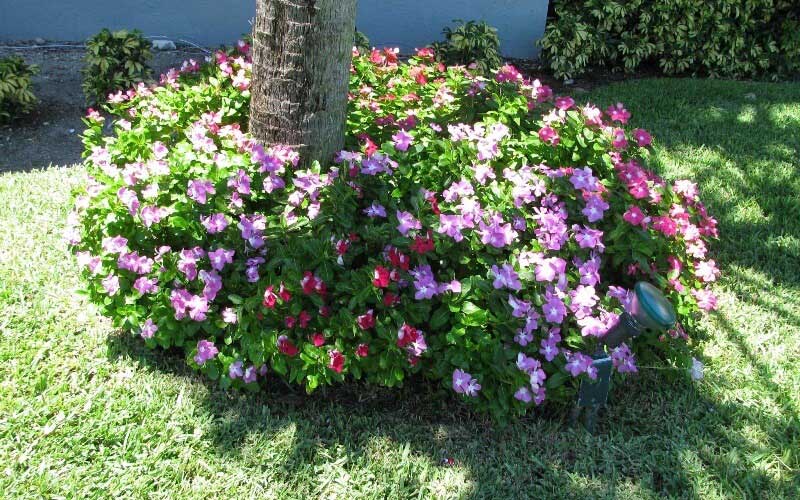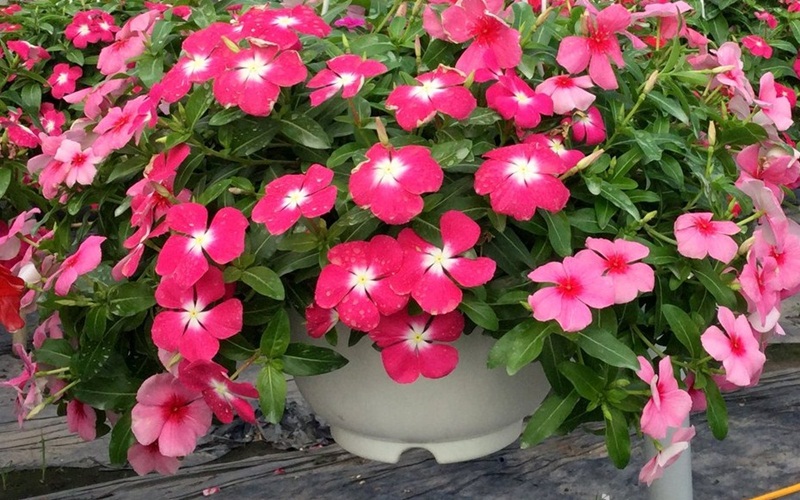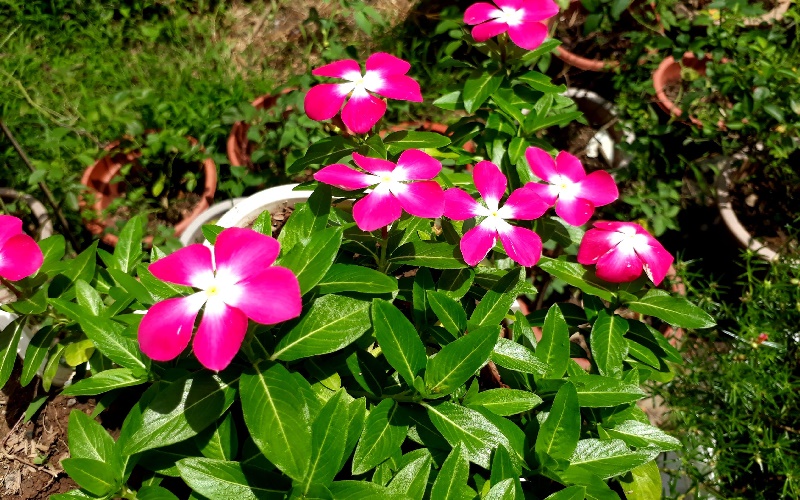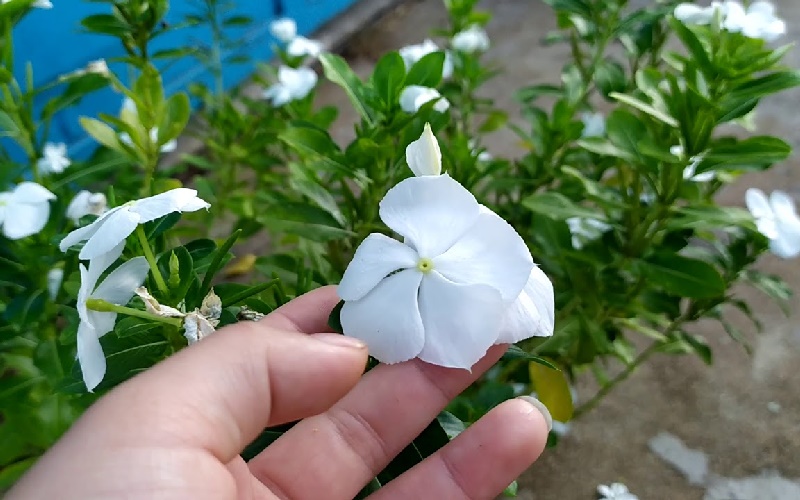The Periwinkle plant, or Catharanthus roseus, is a familiar name to many of us. A simple Google search will yield extensive information about this plant. However, if you want to know more about its specific benefits and proper care, read on!
1 Periwinkle Plant Features
 Periwinkle’s vibrant purple and pink flowers
Periwinkle’s vibrant purple and pink flowers
Also known as Yang Jiao or Truong Xuan, the periwinkle plant is a member of the Apocynaceae family. It grows in bushes, reaching heights between 30 and 90 cm. Unlike the water coconut tree, which has rounded leaves with blunt tips, the periwinkle plant has long, pointed leaves that are green. Its flowers, which grow in the leaf axils, are typically pink, white, or red. The fruit is oval-shaped and contains tiny seeds. Periwinkle plants have a cluster root system.
This plant is native to many countries worldwide, including Brazil, Indonesia, India, and Vietnam. There are four types of periwinkle: trailing, upright, and feng shui periwinkle. Each variety has unique characteristics and comes in a range of colors, including purple, pink, and white.
2 Significance of Periwinkle
 Trailing periwinkle adds a splash of color to your home
Trailing periwinkle adds a splash of color to your home
Ornamental Purposes: With its array of colors and long blooming season, periwinkle is often used to decorate windowsills, balconies, and public flower beds. It blooms from spring to autumn.
Symbol of Good Fortune and Health: Periwinkle is a popular gift choice for various occasions, including holidays, birthdays, and longevity celebrations. It is believed to bring good luck, positive energy, wealth, and good health to the recipient.
Representation of Success: Beyond its association with wealth, periwinkle also symbolizes success. It is often given as a gift to wish the recipient academic achievement and a prosperous career.
3 Medicinal Uses of Periwinkle
 Periwinkle’s beauty and medicinal properties
Periwinkle’s beauty and medicinal properties
According to Master’s Degree holder and Doctor Hoàng Khánh Toàn, head of the Traditional Medicine Department at the Central Military Hospital, recent research in modern pharmacology has revealed the presence of valuable compounds in the roots and leaves of the periwinkle plant. These include Vinblastine, Vincristine, and Vinleurosin.
While Vinblastine has shown effectiveness against cancer, its concentration in the periwinkle plant is still relatively low.
Additionally, Canadian scientists have discovered the presence of Vincaleucoblastin and three alkaloids—Leucosin, Leurocristine, and Leurosidin—in the plant, which are believed to possess anti-tumor properties.
In traditional medicine, periwinkle is valued for its ability to treat parasitic worms and reduce fever. The leaves are also used to address various skin conditions.
In Vietnam, practitioners of traditional Eastern medicine often use periwinkle to prepare herbal remedies for treating hypertension, diabetes, insomnia, and anxiety.
4 Herbal Remedies Using Periwinkle
 Periwinkle’s versatility in Eastern medicine
Periwinkle’s versatility in Eastern medicine
Periwinkle is renowned for its therapeutic properties, especially in treating the following conditions:
Hypertension:
Combine 20 grams of dried periwinkle with 20 grams of mulberry leaves. Brew this mixture in an earthenware pot, and drink the infusion two to three times a day. After a few weeks, you should notice an improvement in your blood pressure levels.
Bacterial Dysentery:
Gather the following ingredients: 15 grams of pennywort, 10 grams of Coptis chinensis, 15 grams of ink plant, 15 grams of toasted periwinkle leaves, 10 grams of glossy privet fruit, 15 grams of ginseng, 15 grams of bitter herb, and 15 grams of milkweed. Clean and boil these ingredients in a liter of water. Reduce the heat and simmer until the liquid is reduced by half. Divide the decoction into three equal parts and consume three times daily.
Pain Relief:
Combine 15 grams of periwinkle leaves with 15 grams of Pagoda tree leaves. Grind this mixture into a paste and apply it to the affected area. Wrap the area with a thin cloth and repeat this process for a month to alleviate pain.
Insomnia:
Mix 20 grams of periwinkle stems and leaves with 15 grams of silk tree leaves and 15 grams of silk tree mimosa seeds. Brew this mixture and drink the infusion before bedtime to improve sleep quality.
5 Precautions When Using Periwinkle
 Periwinkle should be avoided by pregnant and breastfeeding women
Periwinkle should be avoided by pregnant and breastfeeding women
Despite its medicinal benefits, it is important to exercise caution when using periwinkle. It is not recommended for pregnant and breastfeeding women. Additionally, individuals with low blood pressure should refrain from consuming periwinkle.
Using periwinkle as a herbal remedy may cause side effects such as headaches, loss of appetite, diarrhea, and hair loss.
Consult a healthcare professional or pharmacist before incorporating periwinkle into your treatment regimen to minimize the risk of adverse effects.
6 How to Grow and Care for Periwinkle
 Periwinkle in full bloom
Periwinkle in full bloom
To ensure your periwinkle plant thrives and blooms abundantly, follow these planting and care instructions:
Planting Periwinkle:
Select healthy, robust periwinkle seeds and soak them in warm water for about five hours. Prepare a soil mixture of husk, coconut fiber, and black sand.
Fill a cup with the soil mixture and poke a hole in the center for drainage. Use a toothpick to create a hole in the soil, insert a soaked periwinkle seed, and cover it with soil. Mist the soil with water, and once the seed has germinated, continue watering to encourage growth. When the plant reaches about one gang (approximately 30 cm) in height, transplant it into a pot or flower bed.
Caring for Periwinkle:
Watering: Water your periwinkle plant by misting it with a spray bottle to avoid overwatering. The best time to water is in the morning and evening, as this helps the plant retain moisture for a more extended period.
Fertilizing: Mix one teaspoon of fertilizer with one liter of water and use this solution to feed your plant every ten to fifteen days to promote lush growth.
Temperature: Periwinkle thrives in dry, sunny, and airy locations with temperatures ranging from 20°C to 25°C. Ensure the soil is well-drained to prevent root rot.
Now you have a comprehensive understanding of the periwinkle plant, its beauty, and its benefits. Why not add a few pots of periwinkle to your living space to enjoy its vibrant colors and positive energy?
































